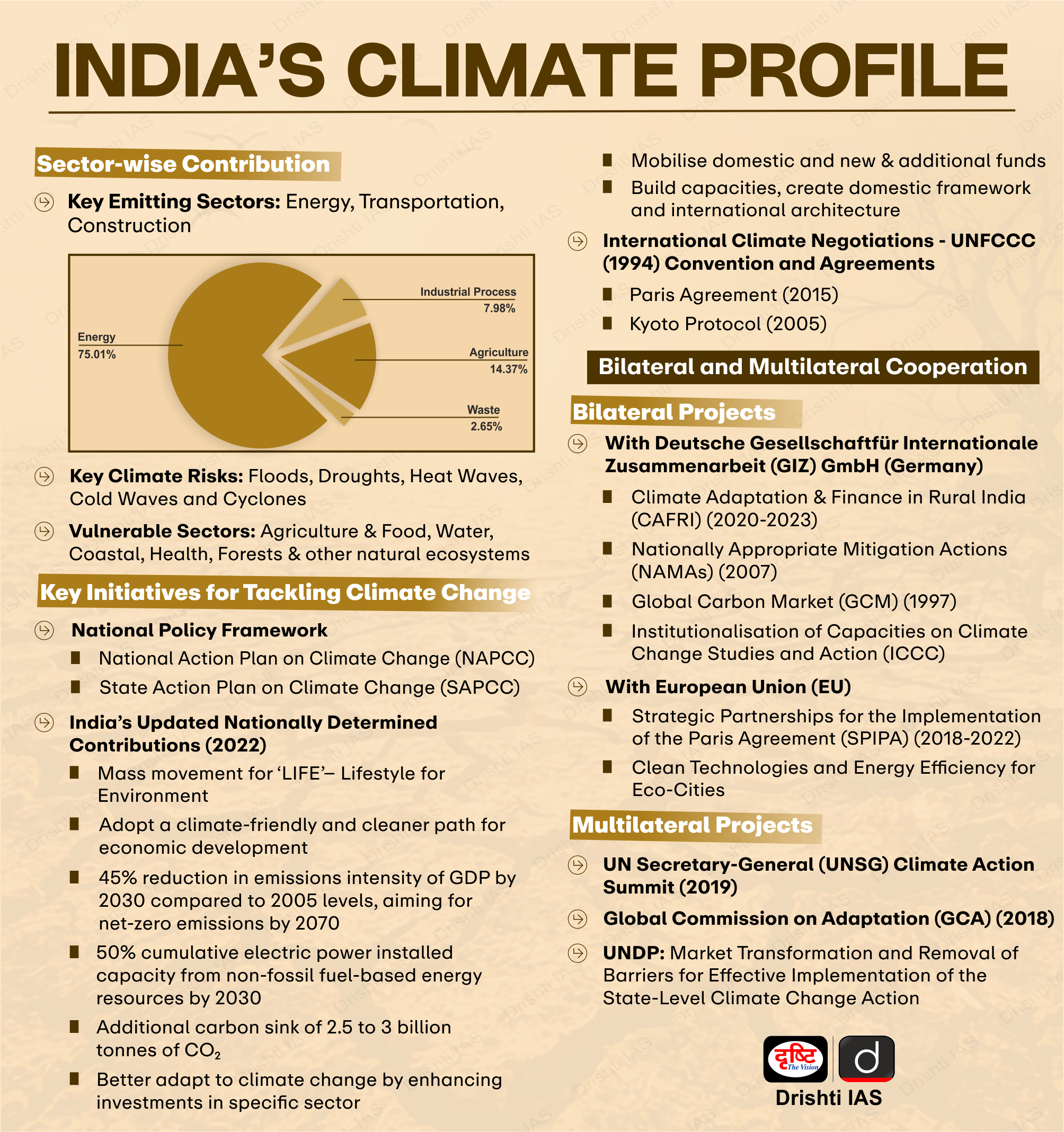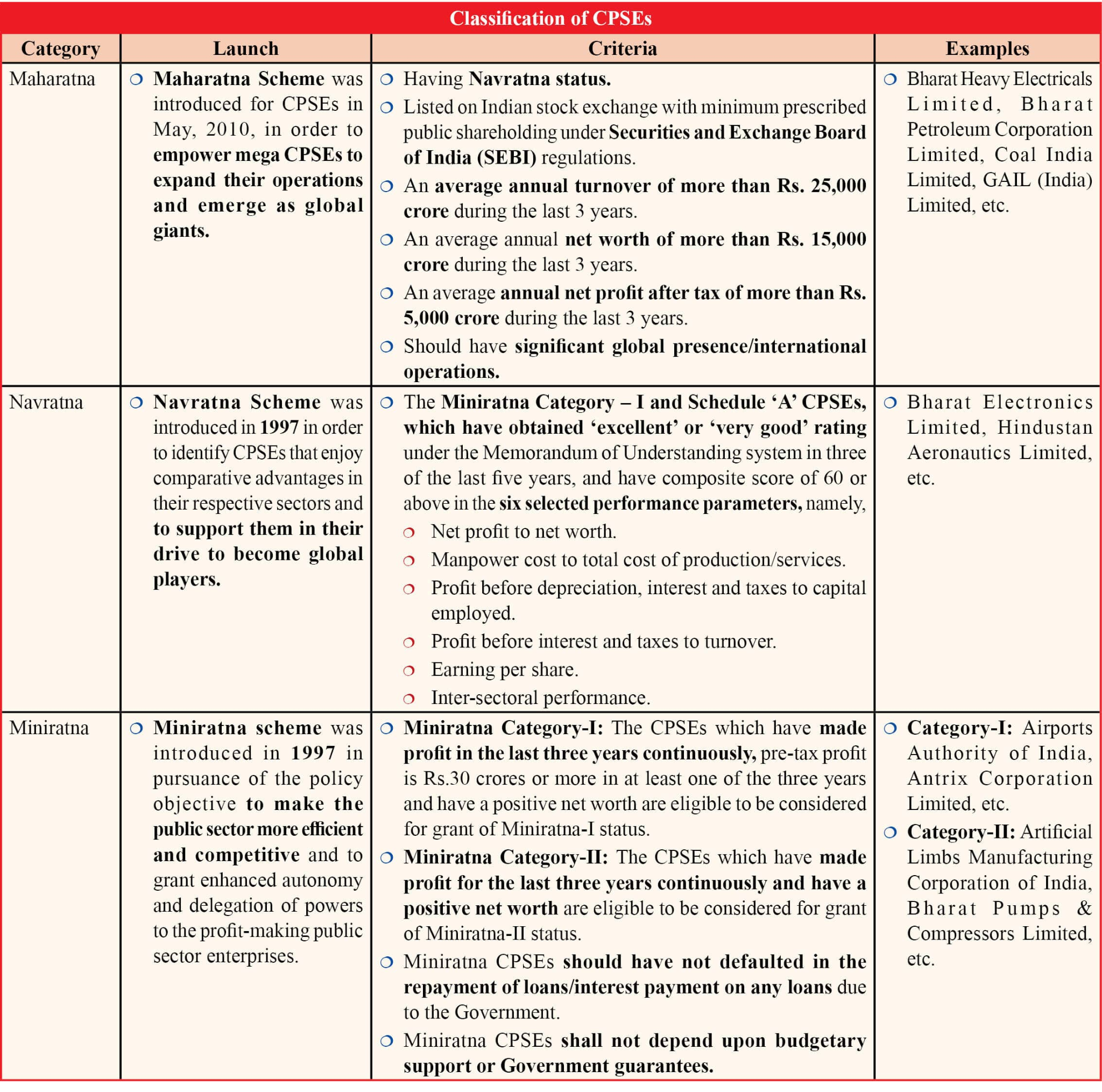Infographics
Biodiversity & Environment
State of the Global Climate 2023: WMO
For Prelims: State of the Global Climate 2023: WMO, World Meteorological Organization (WMO), Greenhouse gas (GHG), Atlantic Meridional Overturning Circulation (AMOC).
For Mains: State of the Global Climate 2023: WMO, Environmental pollution and degradation.
Why in News?
Recently, the World Meteorological Organization (WMO) has released its State of the Global Climate 2023 report, which highlights that the heat content of the world’s oceans reached a record high in 2023.
- Additionally, weather and climate hazards have compounded concerns over food security, population displacements, and impacts on vulnerable populations in 2023.
What are the Key Highlights of the Report?
- Record-High Ocean Heat Content:
- The heat content of the world's oceans reached a record high in 2023, with the highest level of ocean heat content ever recorded.
- This increase in ocean heat content is attributed to anthropogenic climate drivers such as greenhouse gas (GHG) emissions and changes in land use.
- Contrasting Heating and Cooling Patterns in the North Atlantic:
- While the majority of the world's oceans are experiencing warming, relatively small regions, such as the subpolar North Atlantic Ocean, are experiencing cooling.
- This cooling is linked to the slowdown of the Atlantic Meridional Overturning Circulation (AMOC), a system of ocean currents.
- AMOC is a system of ocean currents that circulates water within the Atlantic Ocean, bringing warm water north and cold water south.
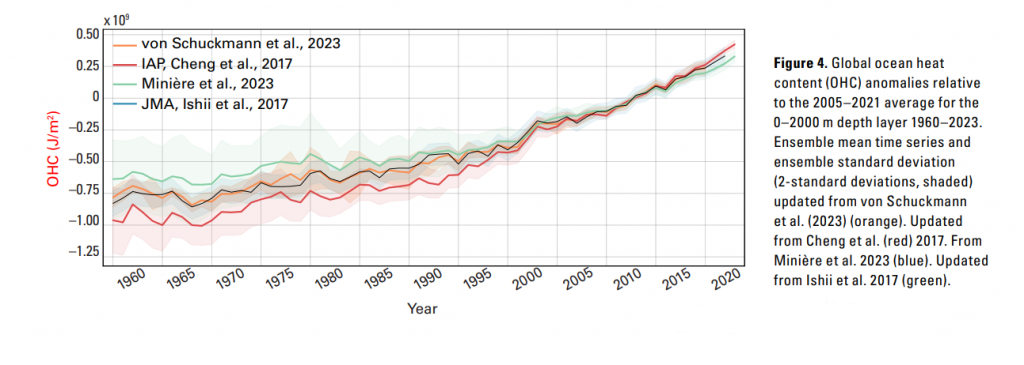
- Global Average Sea-Surface Temperatures:
- Global average sea-surface temperatures (SST) were at a record high in 2023, with several months breaking previous records by significant margins.
- Exceptional heating was observed in various regions including the eastern North Atlantic, the Gulf of Mexico, the Caribbean, the North Pacific, and large areas of the Southern Ocean.
- Marine Heatwaves and Ocean Acidification:
- The global ocean experienced an average daily Marine Heatwave coverage of 32%, well above the previous record of 23% in 2016.
- At the end of 2023, most of the global ocean between 20° S and 20° N had been in heatwave conditions since early November.
- The end of 2023 saw a broad band of severe and extreme marine heatwave across the North Atlantic, with temperatures 3°C above average.
- These heat waves have negative repercussions for marine ecosystems and coral reefs. Additionally, ocean acidification has increased due to the absorption of carbon dioxide by the oceans.
- Global Mean Near-Surface Temperature:
- The global mean near-surface temperature in 2023 was 1.45 ± 0.12 °C above the pre-industrial 1850–1900 average, making it the warmest year on record.
- Every month from June to December was record warm for the respective month, and the long-term increase in global temperature is attributed to increased concentrations of greenhouse gases in the atmosphere.
- Accelerating Glacial Retreat and Antarctic Sea Ice Loss:
- Glaciers worldwide experienced the largest loss of ice on record, driven by extreme melt in both western North America and Europe.
- Antarctic sea ice extent reached an absolute record low for the satellite era, and Arctic sea ice extent remained well below normal.
- Increased Frequency and Intensity of Extreme Weather Events:
- Extreme weather events such as heatwaves, floods, droughts, wildfires, and tropical cyclones had major socio-economic impacts on all inhabited continents.
- Flooding linked to extreme rainfall from Mediterranean Cyclone Daniel affected Greece, Bulgaria, Türkiye, and Libya with particularly heavy loss of life in Libya in September 2023.
- Tropical Cyclone Freddy in February and March 2023 was one of the world’s longest-lived tropical cyclones with major impacts on Madagascar, Mozambique and Malawi.
- Tropical Cyclone Mocha in 2023, was one of the most intense cyclones ever observed in the Bay of Bengal and triggered 1.7 million displacements across the sub-region from Sri Lanka to Myanmar and through India and Bangladesh, and worsened acute food insecurity.
- Extreme weather events such as heatwaves, floods, droughts, wildfires, and tropical cyclones had major socio-economic impacts on all inhabited continents.
- Renewable Energy Surge:
- Renewable energy generation surged in 2023, with renewable capacity additions increasing by almost 50% from the previous year.
- This growth indicates the potential for achieving decarbonisation targets and transitioning to clean energy sources to mitigate climate change.
- Climate Financing Challenges:
- In 2021/2022, global climate-related finance flows reached almost USD 1.3 trillion, nearly doubling compared to 2019/2020 levels. Even so, tracked climate finance flows represent only approximately 1% of global GDP.
- There is a large financing gap. In an average scenario, for a 1.5°C pathway, annual climate finance investments need to grow by more than six times, reaching almost USD 9 trillion by 2030 and a further USD 10 trillion through 2050.
- Adaptation finance continues to be insufficient. Though adaptation finance reached an all-time high of USD 63 billion in 2021-22, the global adaptation financing gap is widening, falling well short of the estimated USD 212 billion per year needed up to 2030 in developing countries alone.
What were the Socioeconomic Impacts of Weather and Climate Hazards?
- Food Insecurity:
- Extreme weather events such as floods, droughts, and storms led to crop and livestock production losses, exacerbating food insecurity globally.
- The acute food insecurity more than doubled from 149 million people affected before the Covid-19 pandemic to 333 million in 2023.
- This crisis is the largest in modern human history, indicating the profound impact of climate-related events on food availability and access.
- Population Displacement:
- Displacements occurred in regions like Syria, Lebanon, Jordan, Iraq, Egypt, Somalia, and Pakistan where communities were already vulnerable due to conflict or previous climate-related events.
- These displacements strain resources and exacerbate social tensions, contributing to instability in affected regions.
- Displaced populations living in temporary shelters are particularly vulnerable to disease outbreaks, which can further strain healthcare systems already grappling with the impacts of climate-related disasters.
- Economic Losses:
- These losses include damage to infrastructure, agricultural productivity, and livelihoods.
- The destruction of agricultural areas due to flooding and storms, as well as the disruption of supply chains, hinders economic recovery and exacerbates poverty in affected regions.
- Inequality:
- Migration and displacement due to climate-related shocks and stresses affect people’s livelihoods which affect various Sustainable Development Goals (SDG).
- These include poverty (SDG 1) and hunger (SDG 2), direct threats to their lives and well-being (SDG 3), widening inequality gaps (SDG 10), limited access to quality education (SDG 4), water and sanitation (SDG 6) as well as clean energy (SDG 7).
- Pre-existing gender and socio-economic inequalities mean women and girls are among the worst affected, impacting SDG5.
- Migration and displacement due to climate-related shocks and stresses affect people’s livelihoods which affect various Sustainable Development Goals (SDG).
- Global Economic Impact:
- The socioeconomic impacts of climate-related disasters extend beyond individual countries and regions, affecting global economic stability.
- Rising food prices, disruptions to supply chains, and increased humanitarian aid expenditures strain resources and contribute to economic uncertainty on a global scale.
What is the World Meteorological Organization (WMO)?
- The World Meteorological Organization (WMO) is an intergovernmental organisation with a membership of 192 Member States and Territories.
- India is a member of WMO.
- It originated from the International Meteorological Organization (IMO), which was established after the 1873 Vienna International Meteorological Congress.
- Established by the ratification of the WMO Convention on 23rd March 1950, WMO became the specialised agency of the UN for meteorology (weather and climate), operational hydrology and related geophysical sciences.
- WMO is headquartered in Geneva, Switzerland.
UPSC Civil Services Examination, Previous Year Questions (PYQs)
Prelims:
Q. “Momentum for Change: Climate Neutral Now” is an initiative launched by (2018)
(a) The Intergovernmental Panel on Climate Change
(b) The UNEP Secretariat
(c) The UNFCCC Secretariat
(d) The World Meteorological Organisation
Ans: (c)
Mains:
Q. ‘Climate change’ is a global problem. How India will be affected by climate change? How Himalayan and coastal states of India will be affected by climate change? (2017)

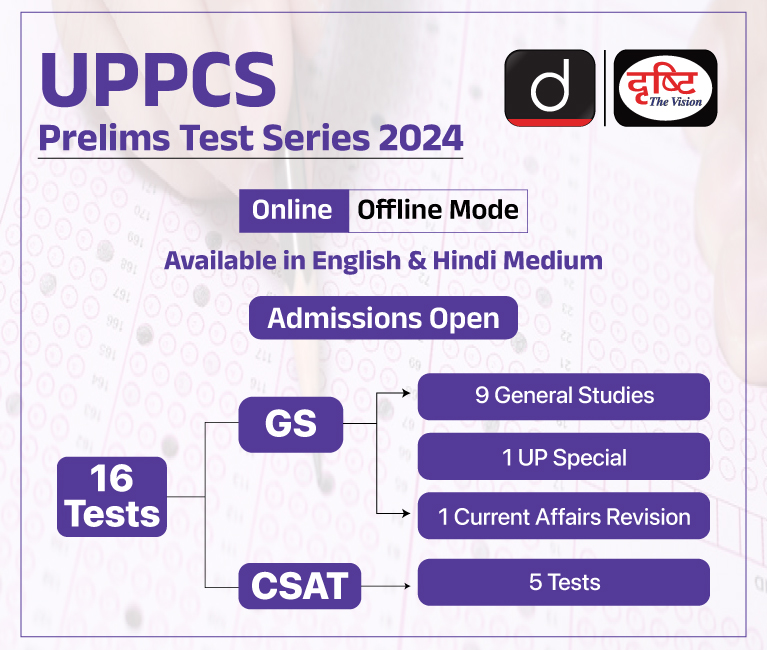
Economy
RBI Integrated Ombudsman Scheme
For Prelims: Reserve Bank of India (RBI), Digital Banking, NBFCs (Non-banking Financial Companies).
For Mains: RBI Integrated Ombudsman Scheme, Indian Economy and issues relating to planning, mobilization of resources, growth, development and employment.
Why in News?
Recently, the Reserve Bank of India (RBI) has reported a spike of 68.2% in complaints under its Integrated Ombudsman Scheme (RB-IOS) for the financial year 2023, with figures reaching a staggering 703,000.
- This leap marks a substantial rise compared to the previous years, where FY22 saw a 9.4% increase and FY21 witnessed a 15.7% hike in complaints.
What are the Factors Behind this Surge in Complaints?
- The central bank's vigorous public awareness initiatives played a significant role in encouraging people to voice their concerns and grievances. As people become more aware of their rights and avenues for complaint resolution, they are more likely to report issues they encounter with banks and non-bank payment system participants.
- The implementation of a streamlined process for lodging complaints makes it easier for the public to report issues they face with financial institutions.
- When the process is simplified and accessible, individuals are more likely to engage with it, leading to an increase in the number of complaints received.
- With the growing popularity of digital transactions, especially in the realm of mobile and electronic banking, there is a higher likelihood of encountering issues such as unauthorised or fraudulent transactions.
- The convenience of digital banking also means that any hiccups in the system can affect a large number of users simultaneously, leading to an increase in complaints.
What is an Ombudsman?
- A government official who deals with complaints made by ordinary people against public organisations. This concept of the Ombudsman arrived from Sweden.
- It means an officer appointed by the Legislature to handle complaints against a service or administrative authority.
- In India an Ombudsman is appointed to resolve grievances in the following sectors.
- Insurance Ombudsman
- Income Tax Ombudsman
- Banking Ombudsman
What is RBI Integrated Ombudsman Scheme (RB-IOS)?
- About:
- RB-IOS amalgamates three ombudsman schemes of RBI-banking ombudsman scheme of 2006, Ombudsman scheme for NBFCs of 2018 and Ombudsman scheme of digital transactions of 2019.
- The unified ombudsman scheme aims to provide redress of customer complaints involving deficiency in services rendered by RBI-regulated entities viz. banks, NBFCs (Non-banking Financial Companies) and pre-paid instrument players if the grievance is not resolved to the satisfaction of the customers or not replied within a period of 30 days by the regulated entity.
- It includes non-scheduled primary co-operative banks with a deposit size of Rs 50 crore and above. The integrated scheme makes it a “One Nation One Ombudsman’ approach and jurisdiction-neutral.
- Need:
- The first ombudsman scheme was rolled out in the 1990s. The system was always viewed as an issue by consumers.
- One of the primary concerns was the lack of maintainable grounds on which the consumer could challenge the actions of a regulated entity at the ombudsman or rejection of the complaint on technical grounds, resulting in a preference for the consumer court notwithstanding the extended timelines for redressal.
- The move to integrate the systems (banking, NBFC, and digital payments) and expand the grounds for complaints is expected to see a positive response from consumers.
- Features:
- The Scheme defines ‘deficiency in service’ as the ground for filing a complaint, with a specified list of exclusions.
- Therefore, the complaints would no longer be rejected simply on account of “not covered under the grounds listed in the scheme”.
- The scheme is jurisdiction-neutral and a centralised receipt and processing centre has been set up in Chandigarh for initial handling of complaints in any language.
- RBI had created a provision for the use of Artificial Intelligence tools so that banks and investigating agencies could coordinate in a better way in the fastest time possible.
- The bank customers will be able to file complaints, submit documents, track their status, and give feedback through a single email address.
- There will also be a multilingual toll-free number that will provide all relevant information on grievance redress.
- The regulated entity will not have any right to appeal in cases where an award is issued by the ombudsman against it for not furnishing satisfactory and timely information.
- The Scheme defines ‘deficiency in service’ as the ground for filing a complaint, with a specified list of exclusions.
- Appellate Authority:
- RBI’s Executive Director in charge of the Consumer Education and Protection Department would be the Appellate Authority under the integrated scheme.
- Significance:
- This will help in improving the grievance redress mechanism for resolving customer complaints against RBI's regulated entities.
- It is expected to ensure uniformity and streamlined user-friendly mechanisms which will add value to the scheme and bring customer delight and financial inclusion.
UPSC Civil Services Examination, Previous Year Questions (PYQs)
Prelims:
Q) With reference to the institution of the Banking Ombudsman in India, which one of the statements is not correct? (2010)
(a) The Banking Ombudsman is appointed by the Reserve Bank of India
(b) The Banking Ombudsman can consider complaints from Non-Resident Indians having accounts in India
(c) The orders passed by the Banking Ombudsman are final and binding on the parties concerned
(d) The service provided by the Banking Ombudsman is free of any fee
Ans: (c)
- The Banking Ombudsman Scheme is an expeditious and inexpensive forum for bank customers for resolution of complaints relating to certain services rendered by banks. It was launched in 2006, and was recently amended in 2017.
- All Scheduled Commercial Banks, Regional Rural Banks and Scheduled Primary Co-operative Banks are covered under the Scheme.
- The Banking Ombudsman is appointed by the Reserve Bank from among its officers of the rank of Chief General Manager or General Manager. They shall have tenure not exceeding 3 years at a time.
- Any person aggrieved by the final orders of the Banking Ombudsman can approach the Appellate Authority. The Appellate Authority is vested with the Deputy Governor of the RBI.
- The Banking Ombudsman can consider complaints from Non-Resident Indians having accounts in India in relation to their remittances from abroad, deposits and other bank-related matters.
- The service provided by the Banking Ombudsman is free of any fee.
- Therefore, option (c) is the correct answer.
Q.2 With reference to the ‘Banks Board Bureau (BBB)’, which of the following statements are correct? (2022)
- The Governor of RBI is the Chairman of BBB.
- BBB recommends for the selection of heads for Public Sector Banks.
- BBB helps the Public Sector Banks in developing strategies and capital raising plans.
Select the correct answer using the code given below:
(a) 1 and 2 only
(b) 2 and 3 only
(c) 1 and 3 only
(d) 1, 2 and 3
Ans: B

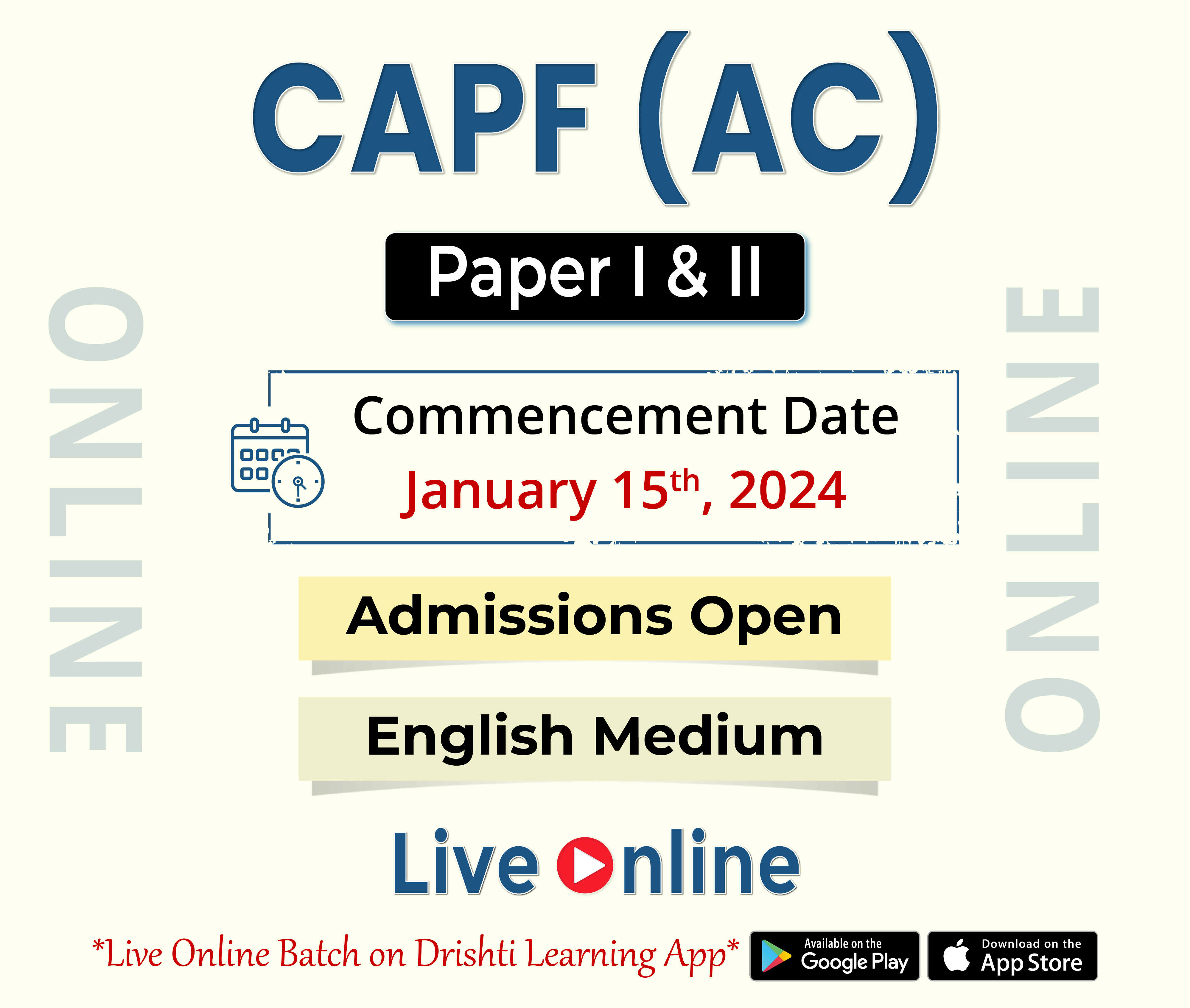
Governance
Low-Carbon Action Plan (LCAP)
For Prelims: Low-Carbon Action Plan, Waste Management, Net Zero, Greenhouse Gas (GHG), Waste to Wealth Portal.
For Mains: Low-Carbon Action Plan, Waste Management Initiatives and Rules, Government Policies & Interventions.
Why in News?
Bihar has initiated a well-designed work plan to strengthen its waste management profile by formulating a Low-Carbon Action Plan (LCAP) for the waste and domestic wastewater sector.
- This is part of its commitment to transform itself into a Net Zero state by 2070.
- The detailed assessment, done by ICLEI (International Council for Local Environmental Initiatives), South Asia, of the waste and wastewater sectors constitutes a critical part of the strategy.
- ICLEI is a network of more than 2500 local and regional governments, supported by a team of global experts, driving sustainable urban development worldwide.
- ICLEI influences sustainability policy and drives local action for low emission, nature-based, equitable, resilient and circular development.
What is the Low Carbon Action Plan (LCAP)?
- About:
- The LCAP is a strategic document developed to address the challenges of Greenhouse Gas (GHG) emissions and promote sustainable waste management practices.
- Specifically tailored to Bihar, the LCAP outlines a comprehensive roadmap for reducing emissions from the waste and domestic wastewater sectors, thereby contributing to the state's goal of becoming carbon neutral by 2070.
- Components:
- Assessment and Inventory: The LCAP begins with a thorough assessment of the existing waste management infrastructure, including both the solid waste and domestic wastewater sectors.
- This involves collecting data on waste generation, treatment methods, and GHG emissions.
- Identification of Key Issues: The LCAP identifies key challenges in waste management, such as inadequate sewage collection and treatment, poor waste segregation, and unmanaged solid waste disposal.
- Setting Targets and Goals: Based on the assessment, the LCAP establishes ambitious targets for emission reductions and waste management improvements.
- These targets are set for different timeframes, including 2030, 2050, and 2070.
- Intervention Strategies: The LCAP proposes a range of low-carbon interventions and recommendations to address the identified issues.
- These strategies include improving waste segregation at the source, enhancing collection and transportation systems, implementing efficient treatment technologies, and promoting methane recovery from wastewater.
- Community Engagement and Policy Enforcement: The success of the LCAP relies on active participation from various stakeholders, including government agencies, local communities, and private sector entities. Additionally, policy-driven enforcement mechanisms are essential to ensure compliance with waste management regulations and promote sustainable practices.
- Assessment and Inventory: The LCAP begins with a thorough assessment of the existing waste management infrastructure, including both the solid waste and domestic wastewater sectors.
What are the Benefits of LCAPs?
- Environmental Benefits: The main advantage is combating climate change by reducing emissions that trap heat in the atmosphere. This can help slow global warming and its associated problems like extreme weather events, rising sea levels, and harm to ecosystems.
- Public health Benefits: Reducing reliance on fossil fuels like coal can improve air quality, leading to less respiratory illness. Low carbon plans often encourage things like walking, cycling, and public transport, which can boost physical activity levels.
- Economic Benefits: Investing in renewable energy sources and energy efficiency can create new jobs in these sectors. There can also be long-term cost savings from reduced reliance on imported fossil fuels.
What are the Challenges of LCAP?
- Upfront Costs: Shifting to renewable energy sources or energy-efficient technologies often requires an initial investment.
- Changing Habits: The plan might require changes in how people live and work, such as using public transport more or driving less. People may be resistant to these changes.
- Political Will: Low carbon plans can take time and sustained effort to show results. There may be political resistance to changes that could disrupt powerful industries.
- Equity Concerns: The transition to a low carbon economy needs to be managed fairly to ensure that everyone benefits and the burden isn't placed unequally on disadvantaged groups.
What are the Initiatives Related to Waste Management in India?
- Solid Waste Management Rules 2016:
- These rules replaced the Municipal Solid Wastes (Management and Handling) Rules, 2000 and focused on segregation of waste at source, responsibility on the manufacturer to dispose of sanitary and packaging wastes, user fees for collection, disposal and processing from the bulk generator.
- Waste to Wealth Portal:
- It aims to identify, develop, and deploy technologies to treat waste to generate energy, recycle materials, and extract resources of value.
- Waste to Energy:
- A waste-to-energy or energy-from-waste plant converts municipal and industrial solid waste into electricity and/or heat for industrial processing.
- Plastic Waste Management (PWM) Rules, 2016:
- It mandates the generators of plastic waste to take steps to minimize generation of plastic waste, prevent littering of plastic waste, and ensure segregated storage of waste at source among other measures.
- In Feb 2022, Plastic Waste Management (Amendment) Rules, 2022 were notified.
- Project REPLAN:
- It aims to make carry bags by mixing processed and treated plastic waste with cotton fibre rags in the ratio 20:80.
- Plastic Waste Management (Amendment) Rules, 2022:
- The rules specify the responsibilities of various stakeholders such as manufacturers, importers, retailers, and consumers. All these stakeholders have a role to play in ensuring that plastic waste is managed properly and does not end up polluting the environment.
Way Forward
- Spread the Burden: Utilize a mix of public and private funding sources to lessen the initial financial strain. Grants, tax breaks, and low-interest loans can incentivize businesses and individuals to adopt low-carbon technologies.
- Focus on Long-term Savings: Emphasize the cost benefits of LCAPs in the long run. This could involve highlighting reduced energy bills from efficiency upgrades or lower healthcare costs due to improved air quality.
- Set Ambitious but achievable Goals: Break down LCAPs into clear, phased milestones to demonstrate progress and keep stakeholders engaged.
- Job Training and Retraining: Invest in programs to equip people with the skills needed for the low-carbon economy, ensuring a just transition for all.
- Make Low-Carbon Options Attractive: Invest in public transportation infrastructure, create bike lanes and walkable communities, and offer subsidies for electric vehicles or energy-efficient appliances.
UPSC Civil Services Examination, Previous Year Questions (PYQs)
Prelims:
Q. As per the Solid Waste Management Rules, 2016 in India, which one of the following statements is correct? (2019)
(a) Waste generator has to segregate waste into five categories.
(b) The Rules are applicable to notified urban local bodies, notified towns and all industrial townships only.
(c) The Rules provide for exact and elaborate criteria for the identification of sites for landfills and waste processing facilities.
(d) It is mandatory on the part of the waste generator that the waste generated in one district cannot be moved to another district.
Ans: (c)
Mains:
Q. What are the impediments in disposing of the huge quantities of discarded solid waste which are continuously being generated? How do we safely remove the toxic wastes that have been accumulating in our habitable environment? (2018)


Important Facts For Prelims
World Sparrow Day 2024
Why in News?
Every year, World Sparrow Day is observed on March 20, shedding light on the significance of sparrows in maintaining biodiversity and ecological balance.
What are the Key Highlights of the World Sparrow Day 2024?
- Theme: In 2024, the theme for World Sparrow Day is “Sparrows: Give them a tweet-chance!”, “I Love Sparrows” and “We Love Sparrows”.
- History: The inaugural World Sparrow Day took place on March 20, 2010. In India, it was initiated by the Nature Forever Society.
- Founded by Mohammed Dilawar, an Indian conservationist, the society aimed to emphasize the importance of conserving house sparrows and other common birds.
What are the Key Facts About Sparrow?
- Sparrows are crucial for biodiversity and plant growth in ecosystems. They consume and excrete seeds, helping to disperse plant seeds and promote vegetation.
- Threats:
- Sparrow populations are declining due to habitat degradation, urbanization, and changes in agricultural practices. The loss of nesting sites and foraging areas, as well as the decline in insect populations, are major factors.
- This decline has wide-ranging effects, including potential increases in insect pests and threats to biodiversity.
- Conservation:
- Efforts include urban greening projects and agroecological practices to create suitable habitats for sparrows.
- Few Common Species Habitat and Distribution in India:
| Sparrow Species | Scientific Name | Habitat Preferences | Distribution in India |
| House Sparrow | Passer domesticus | Urban and rural areas | Widely distributed across India |
| Eurasian Tree Sparrow | Passer montanus | Woodlands, parks, and gardens | Found in various regions across India, less common than house sparrows |
| White-throated Sparrow | Zonotrichia albicollis | Northern regions, mountainous areas | Mainly in Jammu & Kashmir or Himachal Pradesh |
| Chestnut-shouldered Petronas | Petronia xanthocollis | Dry forests, scrublands | Inhabit regions like Rajasthan or Gujarat |
| Rufous Treepie | Dendrocitta vagabunda | Wet regions, forests | Prefers areas such as Assam or West Bengal |
| Baya Weaver | Ploceus philippinus | Coastal areas, wetlands | Commonly seen in coastal regions like Goa or Kerala |
Note
- House Sparrow (Passer domesticus) belongs to the order Passeriformes and the family Passeridae.
- It is the state bird of Bihar and Delhi and is commonly found due to its proximity to human habitations.
- Its conservation status is Least Concern on the IUCN Red List.
Read more: State of India's Birds 2023 Report
UPSC Civil Services Examination, Previous Year Question (PYQ)
Prelims:
Q1. Which of the following is not a bird? (2022)
(a) Golden Mahseer
(b) Indian Nightjar
(c) Spoonbill
(d) White Ibis
Ans: (a)
Q2. Consider the following: (2018)
- Birds
- Dust blowing
- Rain
- Dust blowing Wind blowing
Which of the above spread plant diseases?
(a) 1 and 3 only
(b) 3 and 4 only
(c) 1, 2 and 4 only
(d) 1, 2, 3 and 4
Ans: (d)


Important Facts For Prelims
RBI to Review NBFCs
Why in News?
The Reserve Bank of India (RBI) is gearing up to conduct a comprehensive review of the categorisation of Non-Banking Finance Companies (NBFCs) in 2024.
- The review is seen as a precursor to potentially granting bank licences to select NBFCs.
- Elevating specific NBFCs could serve as a preliminary and evaluative step towards considering them for the allocation of bank licences in the future.
What are NBFCs?
- About: An NBFC is a company registered under the Companies Act, 1956 or Companies Act, 2013, involved in various financial activities like lending, investing in securities, leasing, insurance.
- They offer various banking services but do not have a banking licence.
- Key Features:
- NBFCs provide diverse financial services like personal loans, home loans, vehicle loans, gold loans, microfinance, insurance, and investment management.
- They can accept public deposits for a minimum of 12 months and a maximum of 60 months.
- However, NBFCs cannot accept demand deposits.
- They do not form part of the payment and settlement system and cannot issue cheques drawn on itself.
- Classification:
- On the Basis of Deposits:
- Deposit-taking non-banking finance companies
- Non-Deposit taking Non-Banking Financial Institutions
- On the Nature of their Major Activity:
- Investment and Credit Company
- Consumer Durable Loan Finance
- Core Investment
- Company (CIC)
- Infrastructure Finance Company (IFC)/Infrastructure Debt Fund (IDF)
- Asset Reconstruction Companies (ARC)
- Factoring Companies
- Gold Loan Companies
- Fintech cos: P2P Lenders
- On the Basis of Deposits:
- Licencing: The company must be registered under the Companies Act, 2013, either as a public or private company.
- The company should have a minimum net owned fund of at least Rs. 10 crores to be eligible for NBFC registration.
- At least one-third of the directors of the company must possess relevant work experience in the finance sector.
- The company should have a good track record with CIBIL (Credit Information Bureau India Limited) regarding its credit history and financial credibility.
- The company must comply with all the regulations, norms, and guidelines prescribed under Capital Compliances and the Foreign Exchange Management Act (FEMA) laws.
- Regulation: The RBI has been given the powers under the RBI Act 1934 to register, lay down policy, issue directions, inspect, regulate, supervise and exercise surveillance over NBFCs that meet the 50-50 criteria of principal business.
- The Reserve Bank introduced the Scale Based Regulation (SBR) in October, 2021, categorising NBFCs into Base Layer (NBFC-BL), Middle Layer (NBFC-ML), Upper Layer (NBFC-UL), and Top Layer (NBFC-TL).
- This framework outlines the methodology for identifying NBFCs in the Upper Layer based on their asset size and scoring criteria.
What is the 50-50 Criteria of Principal Business?
- RBI considers a company's principal business to be financial in nature if more than 50% of its total assets and gross income come from financial activities.
- This definition ensures that only companies primarily involved in financial operations are registered as NBFCs and fall under RBI's regulatory oversight.
- Companies primarily engaged in non-financial activities, even if they conduct some financial business on the side, are not regulated by RBI.
- This assessment is commonly referred to as the "50-50 criteria" for determining a company's involvement in financial business.
Note
Demand deposits refer to funds deposited in banks or financial institutions that can be withdrawn by the account holder on demand without any prior notice.
- They are highly liquid and accessible for day-to-day transactions, making them a preferred choice for individuals and businesses needing frequent access to their funds.
UPSC Civil Services Examination, Previous Year Question (PYQ)
Prelims:
Q. With reference to the Non-banking Financial Companies (NBFCs) in India, consider the following statements: (2010)
- They cannot engage in the acquisition of securities issued by the government.
- They cannot accept demand deposits like Savings Account.
Which of the statements given above is/are correct?
(a) 1 only
(b) 2 only
(c) Both 1 and 2
(d) Neither 1 nor 2
Ans: (b)


Rapid Fire
Indian Navy Advances Atma Nirbhar Bharat with ASW SWC Project
Recently, the Indian Navy’s shipbuilding program achieved a significant milestone with the launch of ‘Agray’ and ‘Akshay’, the 5th and 6th ships of the 08 x ASW (Anti-Submarine Warfare) Shallow Water Craft (SWC) Project.
- These ships are being built by M/S Garden Reach Shipbuilders & Engineers (GRSE) in Kolkata for the Indian Navy.
- These ships signify a transition from the aging Abhay Class Corvettes to the more advanced Arnala Class, designed for anti-submarine and mine laying operations in coastal waters.
- The project reflects India's commitment to bolstering indigenous defense manufacturing, with over 80% of the content sourced domestically.
- Notably, in the past year, 3 indigenous warships/submarines have been delivered, with a total of 9 warships launched, underlining the nation's determination to strengthen its maritime capabilities through self-sufficiency.


Rapid Fire
CPCRI Introduces New Varieties for Coconut and Cocoa Cultivation
The Central Plantation Crops Research Institute (CPCRI) recently developed a new variety of coconut along with two new varieties of cocoa aimed at revolutionising coconut and cocoa cultivation in India.
- Kalpa Suvarna, the coconut variety is ideal for tender coconut and copra production, with specific characteristics like large-sized fruits, high water content, and oil content.
- The cocoa varieties, VTL CH I and VTL CH II, have high fat and nutrient contents, with VTL CH II being tolerant to black pod rot.
- Black pod rot is a fungal disease that affects Cocoa Trees. It is majorly caused by fungal species belonging to the genera Phytophthora.
- VTL CH I is suitable for growing in Karnataka, Kerala, Tamil Nadu, and Andhra Pradesh, while VTL CH II is recommended for high rainfall regions in Karnataka, Kerala, Gujarat, and Tamil Nadu.
- Both cocoa varieties yield 1.5 kg to 2.5 kg of dry beans per tree per year.
- CPCRI was founded in 1916 by the Government of Madras and was later incorporated into the Indian Central Coconut Committee in 1947.
- In 1970, it became part of the National Agricultural System (NRS) under the Indian Council of Agricultural Research (ICAR).
- It focuses on researching and developing genetically superior planting materials for coconut, arecanut, cocoa, cashewnut, and spices.


Rapid Fire
India's First Integrated Oil Palm Processing Unit in Arunachal Pradesh
The inaugural commercial operations of India's premier integrated Oil Palm Processing Unit, established by 3F Oil Palm (one of the nation's leading Oil Palm development enterprises), commenced recently. This factory is located in Roing within the lower Dibang Valley of Arunachal Pradesh.
- Despite significant potential, India currently struggles with achieving self-sufficiency in edible oils, importing 96% of its required palm oil, which makes up 67% of the country's edible oil import bill, totaling over Rs. 1 Lakh crore.
- This milestone marks a crucial step in India's quest for self-reliance in edible oils, bolstered by the National Mission on Edible Oils - Oil Palm (NMEO-OP).
- India is the second-largest consumer of edible oil globally and one of its largest importers.
- India imported 16.5 million metric tons (MT) of edible oil in 2022-23 including: palm (9.8 MT from Indonesia, Malaysia and Thailand), soyabean (3.7 MT from Argentina and Brazil) and sunflower (3 MT from Russia, Ukraine and Argentina).
- Indonesia and Malaysia are the main global palm oil producers, followed by Thailand, Colombia, and Nigeria.


Rapid Fire
GRID-INDIA Attains Miniratna Category-I Status
GRID Controller of India Limited (GRID-INDIA) reached a significant milestone as it was designated as a Miniratna Category-I Central Public Sector Enterprise (CPSE) by the Ministry of Power highlighting its pivotal role in the nation's power sector.
- Established in 2009, GRID-INDIA oversees the seamless operation of the Indian Power System, ensuring efficient power transfer within and across regions.
- It manages the All India synchronous grid through five Regional Load Despatch Centres (RLDCs) and the National Load Despatch Centre (NLDC), playing a crucial role in the power landscape.
- GRID-INDIA manages competitive electricity markets, prioritising reliability, sustainability, and fair competition for integrated power system operations.



